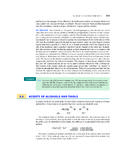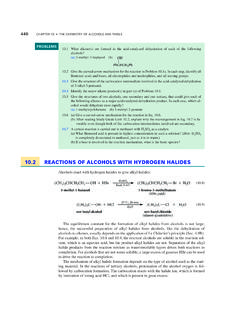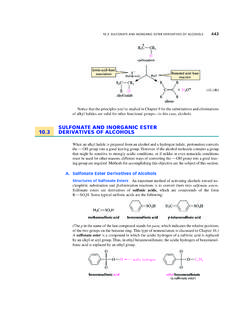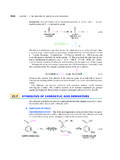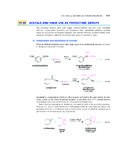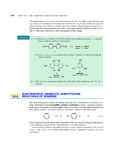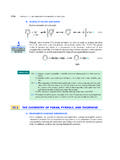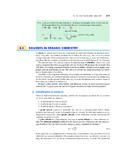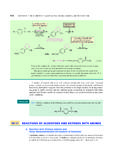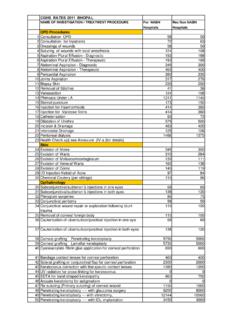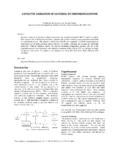Transcription of 19.8 REDUCTION OF ALDEHYDES AND KETONES TO ALCOHOLS
1 914 CHAPTER 19 THE CHEMISTRY OF ALDEHYDES AND KETONES . CARBONYL-ADDITION OF ALDEHYDES AND KETONES TO ALCOHOLSA ldehydes and KETONES are reduced to ALCOHOLS with either lithium aluminum hydride, LiAlH4,or sodium borohydride, NaBH4. These reactions result in the net additionof the elements ofH2across the CAO these examples illustrate, REDUCTION of an aldehyde gives a primary alcohol, and reductionof a ketone gives a secondary aluminum hydride is one of the most useful reducing agents in organic serves generally as a source of H:_, the hydride ion. Because hydrogen is more electroneg-ative than aluminum (Table ), the Al H bonds of the _AlH4ion carry a substantial fractionof the negative charge. In other words,The hydride ion in LiAlH4is very basic. For this reason, LiAlH4reacts violently with waterand therefore must be used in dry solvents such as anhydrous ether and many other strong bases, the hydride ion in LiAlH4is a good nucleophile, and LiAlH4contains its own built-in Lewis acid, the lithium ion.
2 The reaction of LiAlH4with aldehydesand KETONES involves the nucleophilic reaction of hydride (delivered from _AlH4) at the car-bonyl carbon. The lithium ion acts as a Lewis acid catalyst by coordinating to the carbonyloxygen.( )lithium aluminumhydride(reacts furtherwith water)hydrogen gasLi|HHLHHLAlHHHL""O11++_HO113Al_HLi|HL LHH""( )Al_Hreacts as if it wereHHHLL""AlHHHHL""3_( )4 CH3 OHNaBH4p-methoxybenzaldehydesodiumborohy dride4 CH3 OCHOLLA++CH3 OHNa|_B(OCH3)4p-methoxybenzyl alcohol(96% yield)C4 CH3 OOHHHLLL+""( )LiAlH4cyclobutanonelithiumaluminumhydri deLi| and Al3| salts4 VAO+etherH3O|cyclobutanol(90% yield)4 OHHVL"+ 12/9/08 11:41 AM Page REDUCTION OF ALDEHYDES AND KETONES TO ALCOHOLS915 The addition product, an alkoxide salt, can react with AlH3, and the resulting product can alsoserve as a source of processes occur at each stage of the REDUCTION until all of the hydrides are , as shown in the stoichiometry of Eq. , all four hydrides of LiAlH4are active inthe REDUCTION .
3 In other words, it takes one-fourth of a mole of LiAlH4to reduce a mole of alde-hyde or the REDUCTION is complete, the alcohol product exists as an alkoxide addition com-pound with the aluminum. This is converted by protonation in a separate step into the alcoholproduct. The proton source can be an aqueous HCl solution or even an aqueous solution of aweak acid such as ammonium reaction of sodium borohydride with ALDEHYDES and KETONES is conceptually similar tothat of LiAlH4. The sodium ion is a much weaker Lewis acid than the lithium ion. For this rea-son, NaBH4reductions are carried out in protic solvents such as ALCOHOLS . Hydrogen bondingbetween the alcohol solvent and the carbonyl group serves as a weak acid catalysis that acti-vates the carbonyl group. Unlike LiAlH4, NaBH4reacts only slowly with ALCOHOLS and caneven be used in water if the solution is not Eq. shows, all four hydride equivalents of NaBH4are active in the REDUCTION .
4 ( )hydrogen bondS"%CHH"%"%COCH3BH3Na|_HO33%H%O31L+so diummethoxyborohydride (active in furtherreductions)"BH3CH3Na|OL_RRRR( )alcohol productH2O"CO4 HLLHL"+Li|, Al3| salts+aluminum alkoxideaddition compoundCOHLLAlHOH2Li|L""4|_2 RRRR( )AlH3Li|CHLL""O332_AlH3these hydrides are active in further reductionsLi|CHLLL""O32_RRRR( )C+S%%AlH3HL_AlH3 OLi|33a lithium alkoxideLi|RRCHLL"" 12/9/08 11:41 AM Page 915916 CHAPTER 19 THE CHEMISTRY OF ALDEHYDES AND KETONES . CARBONYL-ADDITION REACTIONSB ecause LiAlH4and NaBH4are hydride donors, reductions by these and related reagents aregenerally referred to as hydride important mechanistic point about these reac-tions is that they are further examples of nucleophilic addition. Hydride ion from LiAlH4orNaBH4is the nucleophile, and the proton is delivered from acid added in a separate step (in thecase of LiAlH4reductions) or solvent (in the case of NaBH4reductions).Unlike the additions discussed in Sec. , hydride reductions are notreversible.
5 Reversalof carbonyl addition would require the original nucleophilic group, in this case, H3_, to be ex-pelled as a leaving group. As in SN1 or SN2 reactions, the best leaving groups are the weakestbases. Hydride ion is such a strong base that it is not easily expelled as a leaving group. Hence,hydride reductions of all ALDEHYDES and KETONES are irreversible they go to LiAlH4and NaBH4are highly useful in the REDUCTION of ALDEHYDES and aluminum hydride is, however, a much more reactiveagent than sodium significant number of functional groups react with LiAlH4but not with NaBH4; among suchgroups are alkyl halides, alkyl tosylates, and nitro groups. Sodium borohydride can be used asa reducing agent in the presence of these borohydride is also a much less hazardous reagent than lithium aluminum greater selectivity and safety of NaBH4make it the preferred reagent in many applica-tions, but either reagent can be used for the REDUCTION of simple ALDEHYDES and KETONES .
6 Bothare very important in organic of NaBH4 ReductionsThe discovery of NaBH4reductions illustrates that interesting research findings are sometimesserendipitous (obtained by accident). In the early 1940s, the Army Signal Corps became inter-ested in methods for generating hydrogen gas in the field. NaBH4was proposed as a relatively safe,portable source of hydrogen: addition of acidified water to NaBH4results in the evolution of hydro-gen gas at a safe, moderate rate. To supply the required quantities of NaBH4,a large-scale synthesiswas necessary. The following reaction appeared to be suitable for this purpose.( )4 NaHB(OCH3)3+NaBH43 NaOCH3+( )3-nitrobenzaldehydeO2N"%CHOAO2N"%CH2 OHNaBH4CH3OH(3-nitrophenyl)methanol(m-ni trobenzyl alcohol)(82% yield) the nitro group is not reduced by NaBH4( )comes from acid or solventcomes from _AlH4 or _BH4 SCCHOHO H| %%H 3 _LL"" 12/9/08 11:41 AM Page REDUCTION OF ALDEHYDES AND KETONES TO ALCOHOLS917 The problem with this process was that the sodium borohydride had to be separated from thesodium methoxide by-product.
7 Several solvents were tried in the hope that a significant differencein solubilities could be found. In the course of this investigation, acetone was tried as a recrystalliza-tion solvent, and it was found to react with the NaBH4to yield isopropyl alcohol. Thus was born theuse of NaBH4as a reducing agent for carbonyl investigations, carried out by Herbert C. Brown (1912 2004) at Purdue University, werepart of what was to become a major research program in the boron hydrides, shortly thereafter lead-ing to the discovery of hydroboration (Sec. ). Brown even described his interest in the field ofboron chemistry as something of an accident, because it sprung from his reading a book aboutboron and silicon hydrides that was given to him by his girlfriend (who later became his wife) as agraduation present. Mrs. Brown observed that the choice of this particular book was dictated by thefact that it was among the least expensive chemical titles in the bookstore; in the depression era, stu-dents had to be careful how they spent their money!
8 For his work in organic chemistry, Brown sharedthe Nobel Prize in Chemistry in 1979 with Georg Wittig (Sec. ). ALDEHYDES and KETONES can also be reduced to ALCOHOLS by catalytic hydrogenation. This re-action is analogous to the catalytic hydrogenation of alkenes (Sec. ).Catalytic hydrogenation is less important for the REDUCTION of carbonyl groups than it once wasbecause of the modern use of hydride is usually possible to use catalytic hydrogenation for the selective REDUCTION of an alkenedouble bond in the presence of a carbonyl group. Palladium catalysts are particularly effectivefor this From what aldehyde or ketone could each of the following be synthesized by REDUCTION witheither LiAlH4or NaBH4?(a)(b)(c)OH""OHCH3 CHCH2CH3OH"LCH2OH( )5% Pd/Ccyclohexanecarbaldehyde(81% yield)2-cyclohexenecarbaldehyde"%%HHCHOA +H2%%HHHHCHOA"carbonyl group is not reduced( )SH2 HOHO cycloheptanonecycloheptanol(92% yield)+Ni catalyst102 atm120 12/9/08 11:41 AM Page 917918 CHAPTER 19 THE CHEMISTRY OF ALDEHYDES AND KETONES .
9 CARBONYL-ADDITION of the following ALCOHOLS could notbe synthesized by a hydride REDUCTION of an alde-hyde or ketone? OF ALDEHYDES AND KETONES WITHGRIGNARD AND RELATED REAGENTSG rignard reagents were introduced in Sec. The reaction of Grignard reagents with carbonyl groups is the most important application of the Grignard reagent in organic chem-istry. Addition of Grignard reagents to ALDEHYDES and KETONES in an ether solvent, followed byprotonolysis, gives reaction of Grignard reagents with ALDEHYDES and KETONES is another example of car-bonyl addition. In this reaction, the magnesium of the Grignard reagent, a Lewis acid, bondsto the carbonyl oxygen. This bonding, much like protonation in acid-catalyzed hydration,makes the carbonyl carbon more electrophilic (that is, makes it more reactive toward nucle-ophiles) by making the carbonyl oxygen a better acceptor of electrons. The carbon group ofthe Grignard reagent reacts as a nucleophile at the carbonyl carbon.
10 Recall that this group is astrong base that behaves much like a carbanion(Secs. and ).The product of this addition, a bromomagnesium alkoxide, is essentially the magnesium saltof an alcohol. Addition of dilute acid to the reaction mixture gives an alcohol.( )"1Br_Mg2|H2 OCLL"OH3"1 RRRRCLLL"O33_Mg|BrHOH22|+22++R R ( )SCOMgBrRRRR33%%"a bromomagnesium alkoxide"1 CLL"O33_MgBr|d d+d+R R ( )( )BrMgCH2CH32-methylpropanalethylmagnesiu mbromide2-methyl-3-pentanol(68% yield)(CH3)2 CHCHCH2CH3OH+(CH3)2 CHCHOSL etherH3O|"H3 CCH3 COacetonepropylmagnesiumbromide2-methyl- 2-pentanol(68% yield)+SMgBrCH3CH2CH2 LetherH3O|LLH3CC CH3CH2CH2CH3OH""LLABCH3 CLOHLCH3OH%%CH3OH""STUDY GUIDE LINK Acid 12/9/08 11:41 AM Page 918
